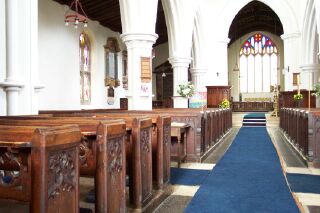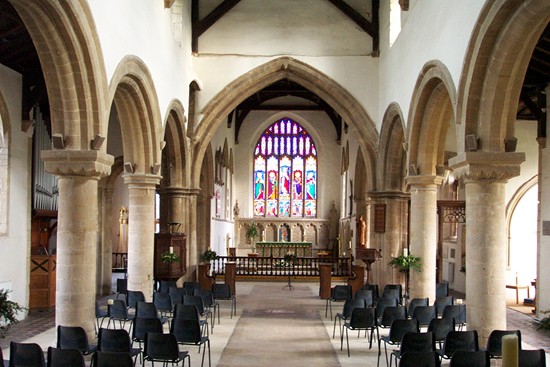|
 |
Benches and pews
in our
parish churches |
The rich golden brown patination
of seasoned oak and pine polished down the centuries by willing hands is one of the
delightful features of our parish churches whether it be pews and pulpits,
lecterns and altar rails, screens, cupboards or coffers.
The preservation of these wooden objects is a sign of the care that has
been lavished on the fittings and furniture and the warm glow they exude
is a welcoming sight for visitors. Oak is the hardest and strongest of our
native timbers, a favourite for the manufacture of benches or pews
which show off the old wood at its best and its value today
is of particular merit when we remember that it was most probably cut and
crafted by local woodsmen and carpenters and so what we see is a mark of
their faith that has survived the centuries.
Unfortunately, pews particularly are being removed at an
alarming rate to provide additional space in the nave for more
diverse community activities and such a change is currently facing many
churches, not least those in the Bourne area, as happened at St Michael's
at Edenham early in 2005 (pictured above).
Opinions were divided because moves to give the building a greater role in
village activities did not please everyone as it involved moving out some
of the pews that had provided seating at services for
generations.
The scheme for the re-ordering of the west end was
designed to create space for baptisms, for people to gather before and
after worship, for children to sit and play, for wheelchairs and prams and
for exhibitions and displays and to enable a friendlier method of entry
into the church which at the time presented a rather crowded prospect for
the visitor. These were radical proposals in a community that was by
definition traditional in its outlook and many believed the removal of
pews to be quite unacceptable. It is therefore worthwhile taking a look at
their history.
Benches or pews in churches are a fairly modern innovation. Before such
facilities were installed, the congregation would stand, even mill about,
although sometimes stone seats can be seen around the base of columns or
against the walls, for use by the infirm, thus giving rise to the
expressions “the weakest to the wall” and “gone to the wall".
Wooden benches were introduced in the 13th and 14th centuries because of
the growing popularity of itinerant preachers, mainly friars from Europe,
when an emphasis on the importance of sermons developed and, because they
were often very lengthy, those in the congregation needed to rest their
weary legs. From the 15th century onwards, they can still be found in
parts of East Anglia and the West Country but did not become a regular
feature of churches in Northern Europe until after the Reformation when
most had acquired some form of seating, often wooden trestles
which could be removed from the nave as required for other purposes.
By the 16th century, most churches had installed permanent long-backed
benches with open rails, bench-ends and book rests for the
benefit of those sitting behind. Rows of seats such as these are often
erroneously referred to as pews whereas these are enclosed and come from a
later date. Nevertheless, it is accepted today that wooden seating in
modern churches is generally referred to as pews and the term benches or
bench-ends to those forms of seating from an earlier period.
One or two of the pews in Edenham church date from the earliest times and
a few have traceried ends, a legacy from the mediaeval church, including
the most fascinating form known as poppy-head, probably derived from
puppis, the figure-head of a ship, while below there are usually carvings
of human figures or animals that sometimes surmount small buttresses at
the sides of the standards or ends. Others are of a more recent century,
probably Victorian, although many have bench ends of antique carved panels
from an earlier period, some humorous such as two bearded heads joined
together that are given a particular mention by Arthur Mee in his Guide to
England - Lincolnshire, first published in 1949. However, it is generally
accepted that a church with poppy-head benches, such as Edenham, cannot
be surpassed for beauty anywhere so far as its seating is concerned.
History therefore poses a dilemma for present day churchgoers. On the one
hand, they are anxious to maintain their church as a conventional place of
worship and on the other to meet the challenge of providing new facilities
for community meetings and other activities that require the additional
space created by the removal of wooden seating. Parochial church councils
intent on such drastic changes need a diplomatic approach in order to
please all parties, the traditionalists and the modernists.
There is also the added incentive that redundant church furniture such as
pews and pulpits command high prices and a PCC that is strapped for cash
to renew the central heating or pay some other pressing bill might easily
be seduced into selling off their old seating to the highest bidder
without really exploring the implications of such a deal and its effect on
the congregation.
Short-term expediency could easily backfire and turn many people away from
the church at a time when every worshipper counts to keep the building
alive as a place of prayer as well as of social gatherings and discourse.
The wisdom of Solomon may be needed to keep the peace between the two.
At Edenham, parishioners were asked to vote on the issue
and the vicar, the Rev Andrew Hawes, issued a short description of the
proposals in his parish magazine, dividing the pews
up into five sections and asking readers to indicate their preferences in
taking out this one or that, removing them all or leaving the church as it
is. They were given until April 16th to make their views known and as many other
churches are likely to face similar problems in the years to come, the
voting will prove to be a most interesting exercise.
|
 |
|
St Firmin’s Church
at Thurlby, two miles south of Bourne, dates back more than a
thousand years and has seen a great deal of restoration and renewal
to maintain the fabric and keep the building in good order for the
benefit of the congregation. In the autumn of 2005, a refurbishment
scheme costing £100,000 was undertaken involving a major alteration
to the appearance of the interior, the removal of the old Victorian
pews that had started to deteriorate, the replacement of the wooden
floor with traditional flagstones and the installation of a modern
heating system. The result has produced a warm, light and welcoming
atmosphere with chairs that can easily be removed and stacked to
provide an open space for community events. Although many deplore
such drastic departures from tradition, churches must consider every
possibility to keep pace with modern living if they are to survive
and Thurlby has succeeded in no small measure. |
UPDATED JANUARY 2005

Go to:
Main Index Villages
Index
|

